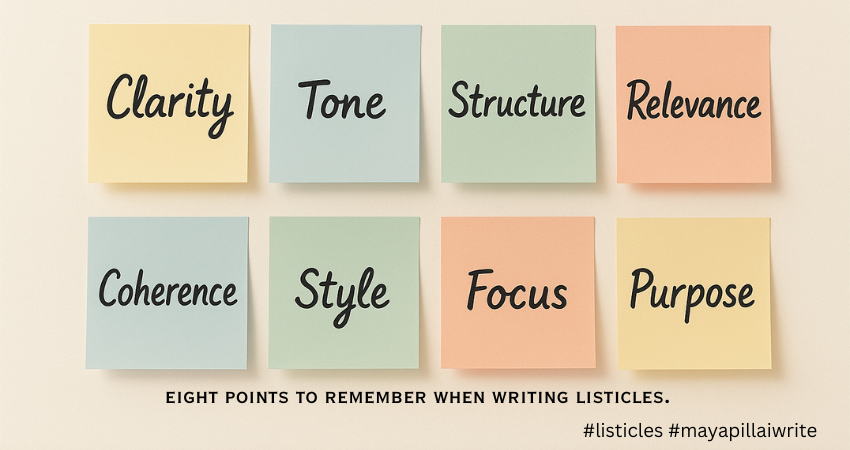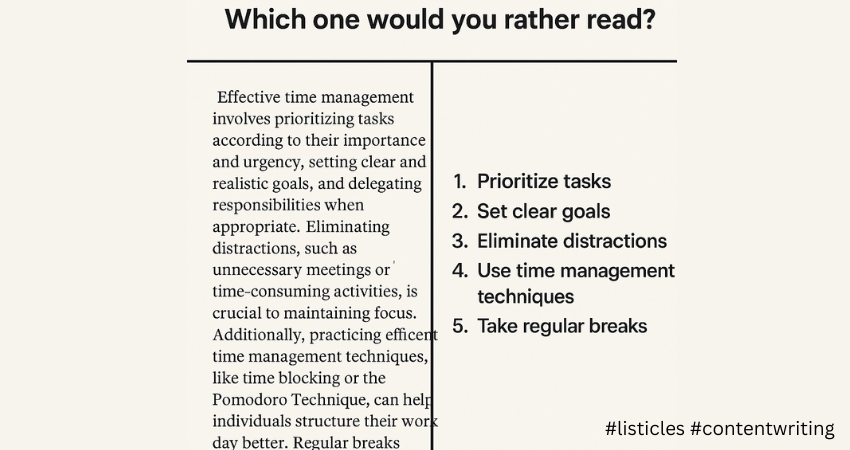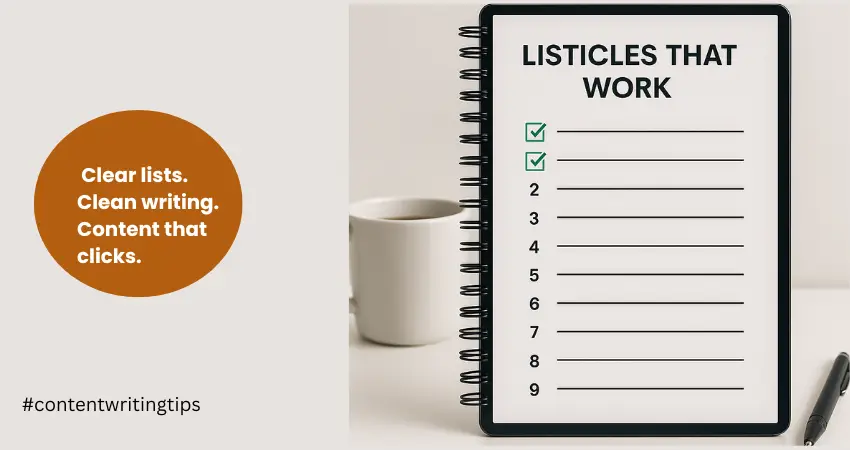What Not to Write in Listicles

Writing listicles isn’t just about numbering ideas. It’s about structure, clarity, and value. This guide covers eight simple things to remember when writing listicles so your content stays readable, engaging, and relevant — without the fluff or repetition that turns readers away.
How to Write Listicles That Actually Work

Writing listicles might seem like a small thing, but if you’ve ever written a blog that felt cluttered or confusing, you already know the value of structure. Listicles solve that problem. They break big ideas into clear steps and help your writing feel more focused from start to finish. They bring structure, make information easier to absorb, and keep the reader moving through the content without getting lost. If you’re still not sure what qualifies as a listicle, start here: What is a Listicle? Key Takeaways Listicles improve structure and readability Each list item should serve one clear purpose Add your voice and end with a soft CTA This blog will show you how to write listicles that are simple, useful, and worth reading. 1. Pick a Topic That Naturally Splits Into Parts Don’t force a list format. Choose something that breaks easily into tips, steps, or points. Examples That Work: “7 Mistakes Freelance Writers Make” “5 Tools Every Blogger Should Use” “10 Ways to Build a Personal Brand Online” Avoid abstract topics like “What is creativity?”—they’re harder to break into points. Want to know why this format performs so well? Read: Why Listicles Work Well 2. Use Numbers in the Title Numbers signal clarity. They tell the reader exactly what to expect. Odd numbers tend to feel more natural, but even numbers work fine if the content delivers value. Examples: “11 Writing Tools That Save Me Hours”“9 Tips for Building Your Writing Routine” “3 Simple Fixes for a Weak About Page” Avoid vague titles like: “Everything You Need to Know About Writing” This gives no sense of structure or value. 3. Start With a Short, Honest Intro Don’t build up too much. Get straight to the point. Example Intro: I struggled with writing blogs that people would actually read. Once I started using listicles, things changed. Here’s what helped me make better content. A simple story or moment of clarity works better than a generic statement. 4. Use Clear Subheadings for Each Point Your subheadings are the anchors. They help readers skim, jump, pause, and resume without confusion. Example: 4. Use Subheadings to Guide the Reader Readers don’t read every word. Subheadings let them find what they need quickly. Listicles support fast reading habits and help with page structure. To understand how this improves UX, check out: How Listicles Improve Readability in Online Content 5. Keep the Flow Tight Listicles aren’t about dumping thoughts into numbered format. Each point should cover one idea clearly. Good Example: a) Use Simple Language Avoid jargon unless your audience expects it. Write like you’re talking. It makes content easier to follow. Bad Example: b) How to Write and Edit While Formatting and Optimizing for SEO This is doing too much. Break this title into 2 articles for better clarity. 6. Add Your Voice Let the reader hear you. Use your tone, even if the format is structured. Example: I once thought listicles were lazy writing. But then one of mine brought in more traffic than anything else that month. Turns out, structure works. Use stories, opinions, or short tips that sound like something you’d actually say. 7. Close with a Nudge Don’t end at the last point and walk away. Wrap things up with a quick thought or question. Examples: Which of these tips are already part of your process? Got a favorite way to write listicles? I’d love to hear it. This encourages comments, bookmarks, or shares without a hard push. To Sum Up Listicles aren’t shortcuts. They’re focused writing. They help you stay on track, break down ideas, and deliver clarity. If you’re building a blog or writing for clients, knowing how to write listicles gives you a format that’s fast to write and easier to read. And that makes both you and your reader happy.
How Listicles Improve Readability

How listicles improve readability lies in their structure. Readers today don’t want to sift through dense paragraphs to find what they need. Listicles solve this by organizing content into numbered or bulleted sections, making it easier to scan and understand. Each point stands on its own, which helps readers stay focused and reduces cognitive load. Whether it’s a quick tip or an in-depth explanation, listicles present ideas in a clear, digestible format. This format also guides the eye naturally down the page, making the reading experience faster and more efficient—especially on mobile screens. Key Takeaways Listicles make content easier to scan and understand. They’re perfect for mobile and quick reading. They boost engagement and reduce bounce rates. Readability isn’t just about font size or white space. It’s about how information is structured, delivered, and processed. Listicles improve readability by addressing all three. Visual structure through numbered pointsThe numbered format allows readers to move easily from one point to the next without losing focus. Each section stands alone but connects to the whole. Frequent stopping pointsListicles offer mental breathing space. Readers can pause after any point, which makes them ideal for mobile reading or multitasking situations. Better skimmabilityEach subheading acts as a signal. Readers who are short on time can find the section most relevant to them and get the value they need without reading everything. Improves accessibility for non-native speakersShort, clear sentences and structured flow are easier to follow, especially for readers who aren’t fluent in the language. This helps reach a broader, global audience. Reduces cognitive fatigueDense blocks of text create friction. A listicle naturally segments content, allowing readers to absorb ideas one at a time without feeling overwhelmed. Supports visual learnersThe structure makes it easy to pair each point with visuals, icons, or screenshots that aid understanding. This strengthens both retention and engagement. Encourages completionWhen readers start a list and know how many items remain, they’re more likely to finish reading the post. It creates a subtle sense of progress and closure. Consistent flowEach item follows a predictable format: subheading, short explanation, example. This rhythm reduces friction and keeps people reading. Enhances mobile readabilityListicles adapt well to smaller screens, where shorter paragraphs and clear breaks improve the reading experience. Increases dwell time and lowers bounce rateBecause they’re easier to read and more engaging, listicles keep people on the page longer—a signal Google uses to measure content quality. To Sum Up Listicles don’t just look cleaner—they’re built for real-world reading habits. They help readers move through content quickly, understand ideas with less effort, and stay engaged from start to finish. Whether someone’s skimming on their phone, juggling tasks, or reading in a second language, the listicle format meets them where they are. With better structure, flow, and clarity, listicles turn complex topics into something that’s easy to follow and hard to abandon.
Why Listicles Work Well

Listicles work well, and I’ve seen that firsthand. When I started using them in my blog posts, I noticed something shift—higher clicks, longer time on page, and more reader interaction. The same content in a standard paragraph format didn’t get the same results. That’s when I realized this format isn’t just convenient. It’s effective. It’s not about being trendy or lazy. It’s about writing in a way people want to read. Times have changed; the attention span of the people are short and competition is everywhere, listicles help your content stand out. Key Takeaways Listicles increase clarity, retention, and engagement. They are SEO-friendly, easy to update, and user-first. Great for both blogs and client content, especially in crowded niches. If you’re new to this format or wondering what exactly qualifies as a listicle, check out this detailed guide on what a listicle is. 9 Benefits of Listicles That Make Them Work So Well Easy to scan People rarely read full blog posts word for word. They scan for key information. Listicles present data in a format where readers can easily find what they need without committing to the entire article. Each point works as a mini-topic, making it easier to digest. Improves readability Readability directly affects user experience and bounce rate. By breaking content into bite-sized segments with clear headers and white space, listicles reduce visual fatigue. This makes it easier for readers to focus and retain information. Drives higher engagement Every list item invites continued reading. A well-crafted listicle encourages scroll behavior, which improves session duration and user interaction. If readers stay longer, they’re more likely to click internal links, comment, or share the post. Enhances SEO performance Search engines favor structured content. Listicles often secure featured snippets because the numbered format aligns with how Google parses direct answers. They also allow for strategic keyword placement without overstuffing. Fits search intent better Listicles align with the way users phrase queries—”top 10 tips for…” or “ways to…” This direct alignment improves relevance, which boosts click-through rates. Users want quick, actionable answers, and listicles deliver just that. Easier to update Unlike narrative posts, updating a listicle is simple. You can add new points, remove outdated ones, or revise sections without disrupting the entire flow. This helps maintain freshness and relevance, both of which impact SEO. Higher shareability Social media users prefer sharing content that’s concise and actionable. Listicles get more traction on platforms like LinkedIn, X (formerly Twitter), and Facebook because they are easy to quote, comment on, or summarize. Builds trust Well-organized content signals authority. When each point is backed with examples, stats, or tools, readers trust the information more. This trust increases the likelihood of return visits and conversions. Works across niches Whether it’s tech, travel, writing, or personal finance, listicles adapt. They can present how-tos, recommendations, mistakes to avoid, or trend roundups with equal efficiency. 10 Psychological Reasons Why Listicles Work Listicles don’t just perform well because of formatting. They tap into how our brains are wired to consume information. Here’s why they connect so strongly with readers: Predictability Knowing how many points to expect gives the brain a roadmap. If a list promises 10 tips, readers feel more confident committing to the article. Progress tracking Each completed point feels like progress. That subtle sense of accomplishment keeps people scrolling through to the end. Chunking of information We process data more efficiently when it’s broken into chunks. Listicles support this by separating ideas into bite-sized segments. Reduced decision fatigue A long article with no structure can feel overwhelming. A numbered list reduces the choices a reader has to make by offering clearly marked options. Cognitive ease The brain prefers simplicity. Listicles use repetition and consistency, making the reading experience smoother and more enjoyable. Anticipation and curiosity Each new item creates a small hook: “What comes next?” That micro-curiosity keeps readers engaged longer. Emotional reward Completing a list gives a small dopamine boost. Readers feel like they’ve “ticked something off,” even when passively consuming content. Visual scanning With numbered points and bold subheads, listicles are easy on the eyes. The design mirrors how people skim content, especially on mobile. Reduced bounce rates Since readers know what to expect and can move through content quickly, they’re less likely to exit mid-scroll. Mental shortcuts People rely on heuristics to make fast decisions. A numbered list feels more credible and authoritative, helping users choose your article over others. There’s a reason we prefer lists over blocks of text. It’s not just style—it’s psychology. Predictability: Knowing there are 7 or 10 items gives a clear mental map. Progress tracking: We feel a sense of accomplishment as we move down the list. Chunking: Our brains process information better in groups. Lists use this to their advantage. This structure plays a key role in retaining attention and improving content recall. Effective listicles usually share three traits: A strong promise in the title Well-researched, actionable points Clean, skimmable layout Whether it’s “5 Security Tools for Small Businesses” or “7 Mistakes to Avoid When Hiring a Writer,” high-performing listicles solve real problems in a focused way. To Sum Up Listicles work well because they make information more accessible. They suit how people read today—fast, distracted, and results-oriented. They’re not about cutting corners; they’re about delivering more value in less time. If you’re looking to increase reach, engagement, and conversions, the listicle format deserves a spot in your content strategy. CTA Want high-performing listicles for your business or client blogs? Let’s collaborate or browse more writing strategies at mayapillaiwrites.com.
10 Things to Know Before Writing a Listicle (With Examples)

Listicles are popular for a reason. They help readers get the point quickly. Whether it’s “5 Ways to Grow on LinkedIn” or “10 Freelance Writing Tips That Actually Work,” listicles break complex ideas into clear, digestible steps. But writing a good listicle isn’t just about listing things. It’s about structuring your content to add real value — not just take up space on the internet. I’ve written all kinds of blog posts — tutorials, explainers, case studies. But listicles? They’re one of the easiest formats to write well and one of the easiest to mess up. A listicle is more than just a bunch of bullet points. When done right, it gives your reader a clear path, real takeaways, and a reason to keep scrolling. Here’s how to write one that works. Key Takeaways A listicle is a blog post or article structured as a list. Each item should offer practical value — no filler. Use examples, order points logically, and format consistently. A strong title and internal linking improve reach and credibility. Best for readers who prefer skimmable, high-utility content. 1. Make Sure Your Content Makes Sense in a List Format Start with the topic. Ask: Can this be broken into clear, stand-alone points? If yes, it’s a good fit for a listicle. For example, “Tips to Improve Blog Headlines” makes sense as a list — each tip can stand alone but still build toward the goal. But “My Journey as a Writer” doesn’t benefit from being in numbered format. That’s a personal story, not a list. Tip: If you feel the need to keep adding context between list items, it may not be a listicle-worthy topic 2. Include Valuable Takeaways — No Fluff! Every point should offer something useful. Don’t just repeat what everyone else is saying. Ask: What does the reader get out of this? Can they apply it right away? Avoid filler like “Be consistent.” Instead, say how to stay consistent — use a content calendar, write at the same time daily, or batch your posts weekly. If it doesn’t teach, guide, or help, cut it. 3. Link to More In-Depth Information When Necessary Listicles aren’t meant to explain everything in detail. But they should point readers to where they can learn more. Add internal links to your own blogs or trustworthy external sources. Example: If one point in your list says “Use a strong CTA,” link to a full blog that breaks down CTA writing techniques with examples. This not only adds SEO value but keeps your content useful even for advanced readers. 4. Explain List Items Using Relatable Examples People remember examples more than abstract advice. Instead of saying, “Write short sentences,” show a before-and-after version: Before: Despite the fact that it was raining, she still went out. After: It was raining. She still went out. Examples make your advice feel real. They also show that you’ve used the tip yourself or thought it through, which builds credibility. 5. Number Your Items Readers love numbers. They signal structure. And in a sea of content, they help people decide whether they have time to read your post. Odd numbers often perform better (e.g., 7 or 11 instead of 10 or 20), but that’s not a rule. What matters more is that the number matches the value you’re offering. Don’t add fluff just to hit a number. Bonus Tip: Mention the number in the title. Example: “7 Ways to Make Your Writing Stronger” 6. Include an Appropriate Number of List Items Too few, and your post feels incomplete. Too many, and your reader may bounce. For most educational blogs, 6–12 items work best. If you go beyond 15, make sure each item still delivers something new. Repetition weakens trust. Quality always beats quantity. Readers will thank you for cutting what isn’t essential. 7. Use Category Buckets for Longer Lists If your list goes beyond 12–15 items, break them into sections with mini-headings. It gives visual breaks and improves readability. Example: In “21 Tools Every Writer Needs,” you might divide them like this: Writing & Editing Visual & Design SEO & Analytics Category buckets also help you avoid repeating similar tools or tips. 8. Logically Order Each Step There are three ways to order list items: Chronologically (for how-to guides or tutorials) By priority (start with the most impactful) By category (if you’re grouping items) Avoid random order unless it truly doesn’t matter. Structure helps people follow your logic and feel guided — even when skimming. 9. Make Sure Your Listicle Is Consistent Consistency in tone, format, and length improves trust and makes the post easier to read. If one point is a sentence and the next is four paragraphs, it feels jarring. Likewise, switching tone from formal to casual can confuse the reader. Keep sentence structures similar. Start each item with an action verb if you’re giving tips. For example: Avoid jargon Write shorter intros Show, don’t tell 10. Have a Clear and Catchy Title Your title should grab attention without misleading the reader. Start with a number, include your main topic, and hint at the value inside. Examples: “10 Ways to Hook Readers With Your Opening Line” “7 Signs Your Freelance Pitch Needs Work” Avoid vague titles like “Writing Tips You Should Know.” They don’t stand out — and they don’t tell readers what they’ll learn. Final Thought Listicles aren’t lazy writing. When structured right, they deliver focused value, reduce reader fatigue, and boost engagement. They’re a smart format for writers who want to share practical advice without overwhelming their audience. Whether you’re creating content for brands or building your own writing blog, learning to write a clean, useful listicle is a skill worth having. Need help turning your ideas into high-performing content?I write SEO-friendly blog posts, listicles, and web content that connect with real readers — and drive results.Work with me or drop a message to see how I can support your brand’s content goals.
